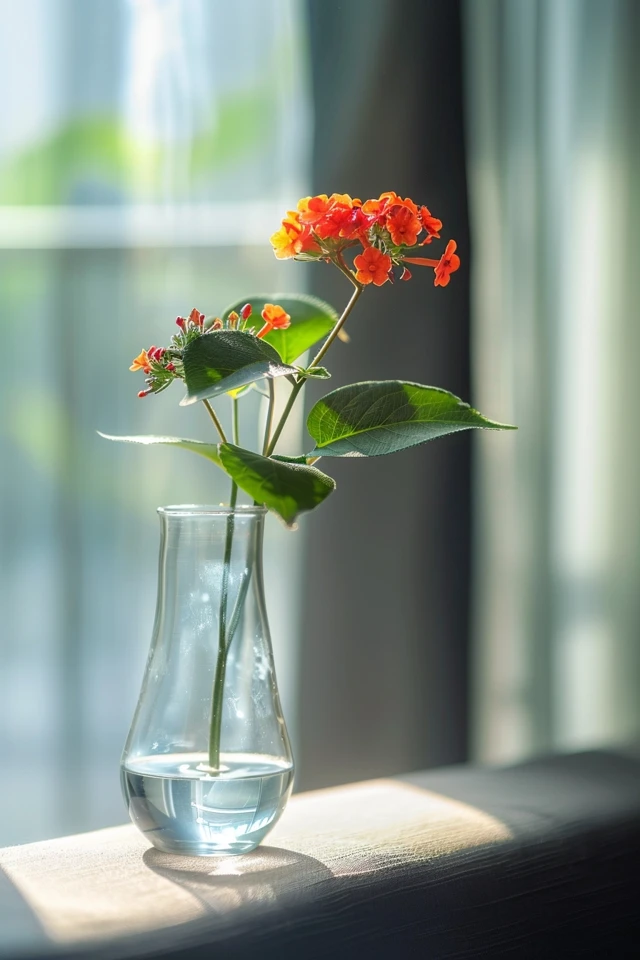Are you looking to propagate lantana plants and create beautiful replicas? Look no further! In this comprehensive guide, I will show you how to successfully root lantana cuttings in water. Whether you’re a seasoned gardener or just starting your journey, this step-by-step process will ensure a high success rate for lantana propagation.
Lantana, with its vibrant colors and attractive foliage, is a popular choice for gardeners. While it can be propagated through seeds, rooting stem cuttings in water is the preferred method for achieving an exact replica of the parent plant.
Key Takeaways:
- Rooting lantana cuttings in water is the best method for replicating the parent plant.
- Springtime is ideal for taking stem cuttings as it allows ample time for root establishment.
- Choose healthy stems with multiple leaf nodes for propagation.
- Prep the cuttings by removing lower leaves and optionally applying rooting hormone.
- Plant the cuttings in a well-draining potting mix and provide proper light and moisture.
Harvesting and Sowing Lantana Seeds
While stem cuttings may ensure an exact replica of the parent plant, growing Lantana from seeds can be a more adventurous option.
When it comes to propagating Lantana, harvesting the seeds is an exciting step. I recommend waiting for the berries to ripen to a deep black color. Once fully ripened, gently extract the seeds from the berries. It’s important to handle them with care to avoid damaging their delicate structure.
After extraction, allow the seeds to dry for a few days. To maintain their viability, store them in a sealed container in the refrigerator until you’re ready to sow them.
Before sowing the seeds, I always soak them in warm water for 12-24 hours. This process helps to soften their tough exterior, aiding in better germination.

Wondering about the right medium for your Lantana seeds?
I recommend filling individual pots with a soilless seed starting medium. Make sure to cover the seeds with a light layer of soil, helping to maintain moisture levels.
To encourage successful germination, it’s important to keep the soil moist. Aim for a temperature range of 70-75°F (21-24°C) to provide an optimal environment for growth.
Germination for Lantana seeds can take 6-8 weeks. It’s essential to remain patient during this time. Remember, the reward of seeing your Lantana seeds sprout and grow into beautiful plants is worth the wait.
Now, it’s important to note that growing Lantana from seeds may result in variations from the parent plant, especially with hybrid varieties. So keep an open mind and embrace the uniqueness that each seedling may bring to your garden.
Creating the Ideal Propagation Environment
To ensure successful Lantana propagation, it’s essential to create the ideal environment. Providing the right conditions will help root Lantana cuttings and promote the growth of seedlings. Here are some tips to help you create an optimal propagation environment for your Lantana plants:
Temperature and Light:
Maintain a temperature of 70-75°F (21-24°C) for optimal growth. Lantana plants thrive in warm conditions, so it’s important to provide them with a consistent and comfortable environment. Place your cuttings and seedlings in an area that receives bright, indirect sunlight. Direct sun can be too intense for tender new growth, so it’s best to provide filtered light. This will prevent the plants from becoming stressed or burnt.

Humidity and Air Circulation:
Proper humidity levels are crucial for successful Lantana propagation. To maintain humidity, you can create a mini greenhouse effect by using a pebble tray or placing a plastic bag over the pots. This will help retain moisture and create a favorable environment for root development. Additionally, good air circulation is important to prevent fungal issues. Consider using a small fan in the propagation area to ensure proper airflow.
Potting Mix and Watering:
Choosing the right potting mix is essential for root development. Use a well-draining mix and incorporate perlite or vermiculite to improve drainage and aeration. This will help prevent waterlogging and promote healthy root growth. Water the cuttings and seedlings appropriately, keeping the soil consistently moist. Regularly check the moisture levels and adjust as needed, being careful not to overwater.
By creating the ideal propagation environment, you can increase the success rate of rooting Lantana cuttings and growing Lantana from seeds. It’s essential to provide the right temperature, light, humidity, and air circulation to ensure the healthy development of these vibrant plants.

Conclusion
Propagating Lantana cuttings in water is a straightforward process that allows for the replication of the parent plant. By following proper stripping, cutting, and planting techniques, stem cuttings taken in the spring have a higher success rate for root development. This method ensures that you can grow new Lantana plants that are identical to the original.
If you’re looking for a more adventurous approach, growing Lantana from seeds can be an exciting option. Keep in mind that this method may result in variations from the parent plant, especially with hybrid varieties. Patience and attention to detail are key when harvesting and sowing Lantana seeds, as germination can take several weeks. However, the potential for unique offspring can add a touch of surprise and diversity to your garden.
To maximize the success of Lantana propagation, creating the ideal environment is crucial. Maintain a temperature between 70-75°F (21-24°C) and ensure bright, indirect sunlight. Proper humidity can be achieved by using a pebble tray or a plastic bag, while good air circulation helps prevent fungal issues. Water the cuttings and seedlings appropriately, keeping the soil consistently moist but not waterlogged. By implementing these techniques and tips, you can enjoy the vibrant beauty of Lantanas in your garden or home.

